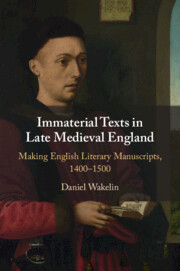95 results
8 - Redesigning the Medieval Book
-
-
- Book:
- Creating Playful First Encounters with the Pre-Modern Past
- Published by:
- Amsterdam University Press
- Published online:
- 17 February 2024
- Print publication:
- 31 August 2023, pp 109-126
-
- Chapter
- Export citation
Figures
-
- Book:
- Immaterial Texts in Late Medieval England
- Published online:
- 12 May 2022
- Print publication:
- 09 June 2022, pp viii-ix
-
- Chapter
- Export citation
General Index
-
- Book:
- Immaterial Texts in Late Medieval England
- Published online:
- 12 May 2022
- Print publication:
- 09 June 2022, pp 278-284
-
- Chapter
- Export citation
Chapter 2 - ‘Hele alle maner of schabbis’
-
- Book:
- Immaterial Texts in Late Medieval England
- Published online:
- 12 May 2022
- Print publication:
- 09 June 2022, pp 23-68
-
- Chapter
- Export citation
Chapter 1 - Prologue
-
- Book:
- Immaterial Texts in Late Medieval England
- Published online:
- 12 May 2022
- Print publication:
- 09 June 2022, pp 1-22
-
- Chapter
- Export citation
List of Manuscripts
-
- Book:
- Immaterial Texts in Late Medieval England
- Published online:
- 12 May 2022
- Print publication:
- 09 June 2022, pp 274-277
-
- Chapter
- Export citation
Abbreviations, Quotations and References
-
- Book:
- Immaterial Texts in Late Medieval England
- Published online:
- 12 May 2022
- Print publication:
- 09 June 2022, pp xii-xvi
-
- Chapter
- Export citation
Acknowledgements
-
- Book:
- Immaterial Texts in Late Medieval England
- Published online:
- 12 May 2022
- Print publication:
- 09 June 2022, pp x-xi
-
- Chapter
- Export citation
Chapter 7 - Conclusions
-
- Book:
- Immaterial Texts in Late Medieval England
- Published online:
- 12 May 2022
- Print publication:
- 09 June 2022, pp 235-239
-
- Chapter
- Export citation
Contents
-
- Book:
- Immaterial Texts in Late Medieval England
- Published online:
- 12 May 2022
- Print publication:
- 09 June 2022, pp vii-vii
-
- Chapter
- Export citation
Chapter 3 - ‘Who by prudence Rule him shal’
-
- Book:
- Immaterial Texts in Late Medieval England
- Published online:
- 12 May 2022
- Print publication:
- 09 June 2022, pp 69-111
-
- Chapter
- Export citation
Chapter 5 - ‘Rede … and ʒe may se’
-
- Book:
- Immaterial Texts in Late Medieval England
- Published online:
- 12 May 2022
- Print publication:
- 09 June 2022, pp 154-191
-
- Chapter
- Export citation
Chapter 4 - ‘Þe leef torned’
-
- Book:
- Immaterial Texts in Late Medieval England
- Published online:
- 12 May 2022
- Print publication:
- 09 June 2022, pp 112-153
-
- Chapter
- Export citation
Chapter 6 - ‘This is the copy’
-
- Book:
- Immaterial Texts in Late Medieval England
- Published online:
- 12 May 2022
- Print publication:
- 09 June 2022, pp 192-234
-
- Chapter
- Export citation
Bibliography
-
- Book:
- Immaterial Texts in Late Medieval England
- Published online:
- 12 May 2022
- Print publication:
- 09 June 2022, pp 240-273
-
- Chapter
- Export citation
Copyright page
-
- Book:
- Immaterial Texts in Late Medieval England
- Published online:
- 12 May 2022
- Print publication:
- 09 June 2022, pp iv-iv
-
- Chapter
- Export citation
Epigraph
-
- Book:
- Immaterial Texts in Late Medieval England
- Published online:
- 12 May 2022
- Print publication:
- 09 June 2022, pp v-vi
-
- Chapter
- Export citation

Immaterial Texts in Late Medieval England
- Making English Literary Manuscripts, 1400–1500
-
- Published online:
- 12 May 2022
- Print publication:
- 09 June 2022
3 - Reading and Understanding Scripts
- from Part I - How Do We Study the Manuscript?
-
-
- Book:
- The Cambridge Companion to Medieval British Manuscripts
- Published online:
- 11 December 2020
- Print publication:
- 17 December 2020, pp 49-75
-
- Chapter
- Export citation
7 - Urinals and Hunting Traps: Curating Fifteenth-Century Pragmatic Books
-
-
- Book:
- New Medieval Literatures 20
- Published by:
- Boydell & Brewer
- Published online:
- 30 April 2020
- Print publication:
- 15 May 2020, pp 216-254
-
- Chapter
- Export citation



